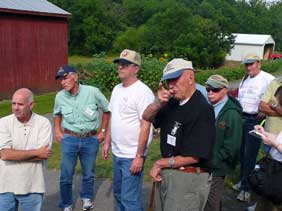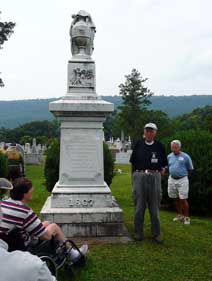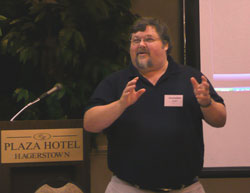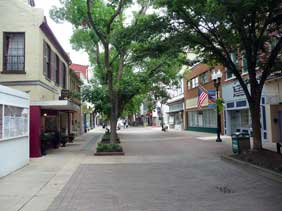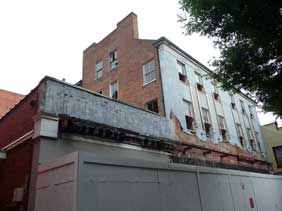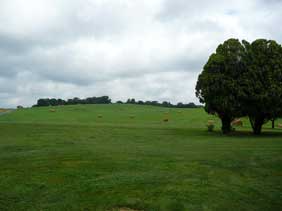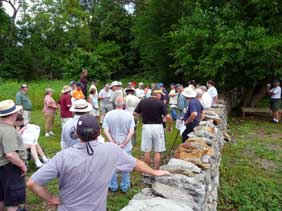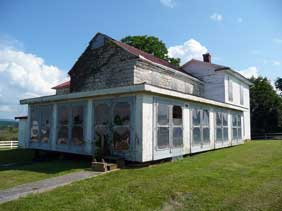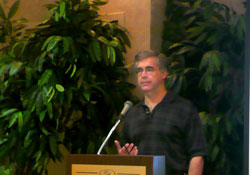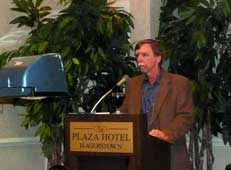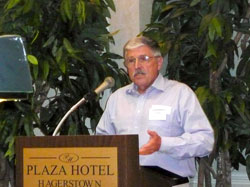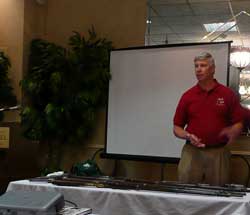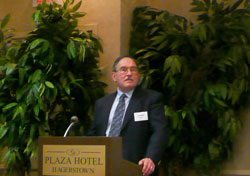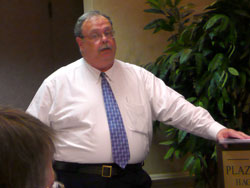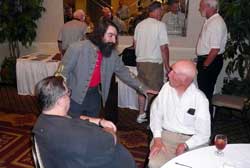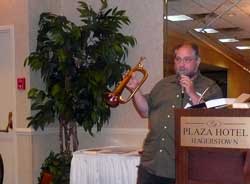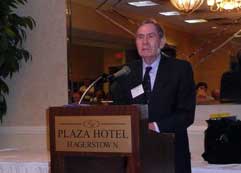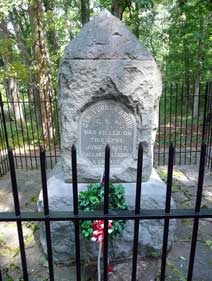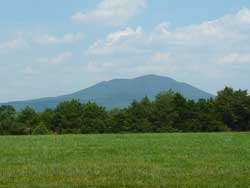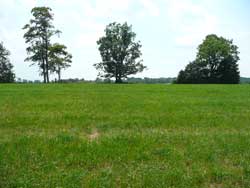2009 Civil War Travelogue (part 3)
| Here is a reminder about the reason I write these pages the way I do. They record my experiences and impressions of Civil War trips primarily for my future use. Thus, they sometimes make assumptions about things I already know and focus on insights that I receive. They are not general-purpose descriptions for people unfamiliar with the Civil War, although I do link to various Wikipedia articles throughout. Apologies about the quality of interior photographs—I don't take fancy cameras with big flashes to these events. If you would like to be notified of new travelogues, connect to me via Facebook. |
Chambersburg Civil War Seminar on Stonewall Jackson's Valley Campaign, July 22-26
In 2007, I attended a great seminar about Antietam arranged by Ted Alexander and the Chambersburg Chamber of Commerce, so I was delighted to sign up for another seminar this year about Stonewall Jackson's Valley Campaign of 1862. (I just finished a big upgrade of that Wikipedia article in time for the seminar, as well as a Zazzle.com T-shirt and coffee mug!) The headquarters hotel is in Hagerstown, Maryland, which is a bit more centrally located for the Shenandoah Valley locations.
As usual, I try to update the site each night with textual descriptions of the day's events, although I am leaving the busy work of photography integration until next week.
Wednesday, July 22
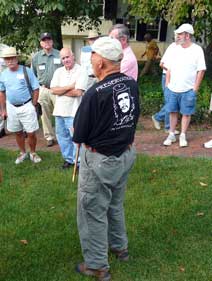 |
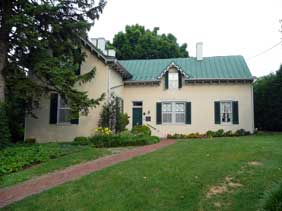 |
Ed's Che tee-shirt |
Jackson's HQ in Winchester (side of house) |
The first day was optional and I would estimate that only about half of the eventual 80 attendees arrived early. I signed up for the optional bus tour about Stonewall Jackson's Romney Expedition, hosted by Ed Bearss and Steve French. (Ed was up to his usual level of excellence. I was unfamiliar with Steve's work previously, but he has a really in-depth knowledge of the Shenandoah Valley. Ed showed up wearing a battlefield preservation T-shirt that had Che Guevara's iconic image on the back. (I understand that Rob Hodge, immortalized in Confederates in the Attic, designed the shirt.)
We drove about 45 minutes to Winchester and visited the outside of Jackson's headquarters in town. (I'm not sure why we made that stop because it is on the agenda for tomorrow as well.) Ed engaged in some amusing speculation about exactly where Jackson's daughter, Julia, was conceived and I think he finally concluded that it was not in the official military office. :-) We stopped for a bathroom break at a huge Sheetz gas station, where Ed revealed some interesting data about horses: they can go number two while they are walking, but not number one. And number one is a good source for hand warming. I will have to remember this the next time I consider shaking the hand of a Civil War reenactor. For the rest of the morning, we attempted to trace Jackson's route toward Romney, West Virginia (or just plain Virginia at the time), as well as the existing road network allowed. This campaign occurred in early January 1862, when Jackson sought to occupy Romney and drive the Federals, commanded overall by Maj. Gen. Nathaniel P. Banks, out of the lower Valley. (I have some background material about the Valley in the Wikipedia article. The lower Valley is actually the northernmost portion, which has a lower elevation. So going "up the Valley" means to travel to the southwest.) It was arguably the campaign with the most punishing bad weather during the war; almost all Civil War armies avoided combat in the dead of winter.
Our first stop was at Unger's Store, where Jackson stayed personally January 8-13 and where his men had to re-shoe all of their horses to account for the icy roads. This was the site of an amusing Jackson anecdote. Mr. Washington Unger allegedly asked Jackson what his campaign plans were and Jackson replied, "Can you keep a secret?" When Unger said yes, Jackson said "So can I." From there he marched, and we drove, to the town of Bath, which is now called Berkeley Springs. Some of these roads were pretty tortuous and very hilly. I can only imagine what it must have been like in mud and ice. Just across the Potomac River is Hancock, Maryland, and we stopped at a church graveyard, which was used for Union artillery to return fire against Jackson's artillery on January 5-6, situated on a tall hill south of the river. Jackson demanded that the town surrender, but Union Brig. Gen. Frederick W. Lander called Jackson's bluff and the Confederates withdrew to head for their original objective, Romney.
Romney must've been an hour and a half away by bus, so I can understand why Jackson's "foot cavalry" started to become pretty testy during this campaign. It is a pleasant little town and we stopped for lunch at Mario's Italian restaurant. One of the guys on the bus happens to be an Italian-American from the New York area and he had artificially high hopes about the spaghetti sauce, but after the meal he exclaimed, "It tasted like Greek." (The sauce was from a can and the meatballs from Costco, he was certain.) Well, I had little invested in high expectations for a West Virginia Italian restaurant, and enjoyed my sausage hoagie. We visited the Indian Mound Cemetery, where Ed and Steve told us about the history of the town and we saw one of the earliest monuments erected to the Confederate dead, in 1867. We drove outside of town and visited a house, "Sycamore Dale," whose claim to fame was that in the front yard in 1865, McNeill's Rangers surrendered (peevishly dumping a pile of rusted, antique flintlocks in front of the Union soldiers). This partisan group, essentially guerrillas, was a West Virginia equivalent of Mosby's Rangers. We walked through a dry creek bed about 100 yards to find a giant stone abutment for the Romney covered bridge over the South Fork of the Potomac River. In June 1861, Brig. Gen. Lew Wallace first occupied Romney by crossing and seizing this bridge, ordering it burned when he withdrew. We concluded our visit to Romney by seeing the outside of the house Jackson used as his headquarters there for a few days, now a private residence. On the long drive back, we stopped at a gas station near a place called Blue's Gap (or Hanging Rock) and talked about a skirmish that was set up to distract Jackson from the Union withdrawal from Romney.
Ed and Steve (center) at Unger's Crossroads |
Romney Cemetery |
Brian Steele Wills at the movies |
Back at the hotel, we had a nice reception with great hors d'oeuvres and got to wander around a very large collection of books for sale. After the feeding died down, Brian Steele Wills talked about his book, Gone with the Glory: The Civil War in Cinema. I had encountered Brian once before at a CWPT event in Memphis and he was equally entertaining here. He showed a number of clips from famous Civil War movies and it was sort of like Mystery Science Theater, with lots of humorous and snide remarks. I did not catch all of the titles, nor did I find all equally interesting, but I did make a note to try to find Journey to Shiloh (with John Doucette as Braxton Bragg!) and The Horse Soldiers. I was disappointed that he did not name what I believe to be the most historically inaccurate of all such movies, They Died with Their Boots On, about George Armstrong Custer.
Thursday
Today was the first full official day of the seminar and we needed two buses for our excursion to the lower Valley. I decided to take the second bus, assuming it would be less popular and I could get a seat to myself (something that is necessary for a guy with legroom issues), and I scored. While the popular Ed Bearss led the first bus, we got the relatively unknown Jonathan Noyales, who is a young history professor at a local community college. I thought Jonathan was really excellent and I was happy with my choice—he was very well informed, organized, and well spoken. He seemed to know an awful lot about the Shenandoah Valley.
 |
||
Downtown Winchester |
Taylor Hotel |
The "crooked button" photo |
We started off in downtown Winchester, which is a delightful little town with lots of historic buildings and a nice pedestrian mall on a few blocks of Loudoun St. Jonathan took us on a walking tour, which included the Presbyterian Manse (where Julia Jackson probably really was conceived), the Court House and Museum, the house where General George S. Patton's grandfather died after Third Winchester, Dr. Hunter McGuire's boyhood home, a grandiose building with giant columns that generals Milroy and Sheridan used as headquarters, a house used as a headquarters for George Washington, and the Taylor Hotel, where a famous photograph of Jackson was taken, one in which he had to sew a missing button onto his uniform and he got it crooked. This is the photograph that makes him look relatively benign with a slight smile on his face and his wife Anna said it was her favorite. Then we spent some extended time—although not nearly enough, according to the staff—inside Jackson's headquarters and museum. This is a really cool experience because it has lots of furniture and objects owned by the Jacksons as well as a big collection of art work about Jackson (both period and modern). Some of the interesting objects were his prayer book and binoculars. The house, named "Alta Vista," was owned by Col. Lewis T. Moore of the 4th Virginia infantry, and his great granddaughter, Mary Tyler Moore, contributed funds to restore parts of the house. A story was told that when Sheridan burned the Valley in 1864, this house was spared because both he and Moore were Masons and a Masonic symbol graced the doorway.
Pritchard Hill (Kernstown) |
Stone wall on Rose Hill (Kernstown) |
Fairview, north of Front Royal |
We drove a few miles south to visit the battlefield of First Kernstown. There are essentially two major portions of the field, Pritchard Hill and Sandy Ridge to the west. We started at the former, which is nicely preserved and you get a great idea of the value of the hill as an artillery platform. The only accessible part of Sandy Ridge, which is where the most important part of the battle was fought, is on a property called Rose Hill, so we saw only a small part of the Confederate line, the position of the 37th Virginia, with a nicely restored stone wall that played a crucial role. It was rather difficult to figure out what was going on because of the heavy vegetation. It was here that Brig. Gen. Richard B. Garnett withdrew his Stonewall Brigade, who were out of ammunition and outnumbered, without getting permission from Stonewall Jackson, an act for which he was court-martialed. Garnett was so humiliated by this experience that he ended up taking foolish risks to show his bravery in Pickett's Charge the following year and was killed. (Jackson had a real reputation for arresting his subordinates for even minor infractions, but this was arguably the most serious case of an injustice.) Kernstown was Jackson's only loss during the campaign, and in fact the only loss during the war, although it is considered a strategic victory for the Confederacy because it caused some of the troops intended for the Peninsula Campaign to be reassigned to the Valley. We had lunch in a place called the Golden Corral, a large and busy buffet restaurant, featuring gargantuan arrays of foods almost universally not good for you, but delicious nonetheless. There was quite a bit of sleepiness observed on the bus after this repast.
We headed south 17 miles to Front Royal. (After Kernstown, the next battle in the campaign was McDowell, but it was much too far away to drive. Not too far away for Jackson's soldiers to march, however.) It was here that Jackson captured a small Federal garrison and turned Banks's position at Strasburg. We started at the Ashbury Chapel, where Jackson planned the battle and found a route that would allow him to sneak up on the Federals—a road that was called Gooney Manor Road at the time, but is now Rocky Lane. We took our giant buses on this hilly and windy road. Next up was the parking lot of a VFW Lodge, next to the site of the original bridge over the South Fork of the Shenandoah River (a few hundred yards downstream from the current highway bridge). Then north to Cedarville, where the 1st Maryland Infantry of the Union garrison made its last stand at the McKay house, Fairview, which is currently an abandoned, dilapidated ultra fixer-upper.
We did not spend much time discussing Banks's retreat from Strasburg to Winchester, which is too bad because it is an interesting study in how to pursue a force when you don't know exactly where they're going to go. However, it became clear that we were running perilously short of time. So we drove directly to the First Winchester battlefield, which is a complete disappointment, because Bowers Hill has been obliterated by a very high-end housing development, so it is virtually impossible to understand what happened there. By that time, we were behind schedule and the highway traffic reports said there was a backup, so we departed for Hagerstown. Along the way, Ed Bearss, who had somehow been traded to our bus for Jonathan, regaled us with a lengthy Q&A session. The first question was whether A.P. Hill and George Custer got gonorrhea from the same woman at West Point. (Very unlikely. And that was Ed asking and answering his own question, by the way.) Next, what were Ed's picks for the top four Union and Confederate generals? On the Union side, it was a pretty standard answer: Grant, Sherman, Thomas, and Sheridan. On the Confederate, I will leave it as a quiz for the reader for his opinion on number one, but the next three were interesting. He thought that Stonewall Jackson and James Longstreet were essentially tied for second, although the answer might have changed if Jackson had been able to serve throughout the war as Longstreet did. Number four was Nathan Bedford Forrest. He also told a funny story about Isaac R. Trimble, who lost a leg at Gettysburg and while detained as a Union POW, repeatedly escaped from the prison on Johnson's Island, so the Union guards had to confiscate his prosthetic leg.
Dinner was on our own and the evening activity was a charity auction for battlefield preservation.
Friday
Today was a day full of lectures at the hotel. We started with Peter Cozzens, author of many books of detailed campaign studies, primarily from the Western Theater, but who has just written a new book called Shenandoah 1862, which has received a lot of favorable comments as one of the only campaign studies that pays attention to both sides, rather than focusing entirely on Jackson. Peter gave an overview of the campaign with little detail about the individual battles. He was initially flustered because he had sent his PowerPoint presentation to Ted Alexander who, being a technophobe, didn't do anything with it, such as bring it to the hotel. So there was a mad rush to find a map of the Valley Campaign on the Internet and I was gratified that they selected one of the ones I drew for the Wikipedia article (my map, one of two for the campaign). Unfortunately for me, having to watch my own map on the big screen for almost an hour allowed me to find five errors in it, and I was gratified that Peter did not point them out. I have since updated the map on Wikipedia (and also the Zazzle T-shirt and coffee mug). One particular insight I received from Peter's presentation was that Banks considered Winchester to be merely a holding action on his way back across the Potomac; I had considered it a regular battle that he hoped to win and then decided to retreat only after getting clobbered.
Peter Cozzens |
Dan Toomey |
Joe Whitehorne |
Next was a panel discussion with five historians: Jonathan Noyales, Steve French, Ed Bearss, Bevin Alexander, and Peter Cozzens. There were a lot of interesting tidbits. Bevin considered Lincoln to have committed a strategic error by going after Stonewall Jackson at all. Jonathan discussed the historiography of the campaign, complimenting Peter's work, and suggesting that the famous Jackson biography by GFR Henderson was flawed because the only Union entry in the bibilography for the Valley Campaign was George H. Gordon's memoir, written by a man who was innately critical of Banks. Ed gave a lengthy comparison of the Valley Campaign to the Vicksburg Campaign, for some reason, being a lot more impressed with the latter. I asked a question of the panel about what evidence anyone had that, if McClellan had been able to retain the services of McDowell's corps in the Peninsula campaign, would he have used it effectively (because he had a history of timidity even with large disparities of forces in his favor). I did not really get a very good answer, although Ed made a reference to the Battle of Hanover Court House, which he said demonstrated McClellan's aggressive mindset at the time. Someone asked a question about whether Turner Ashby was effective during the campaign and Steve said the answer was "mixed." (Way to go out on a limb, Steve.) Peter answered a question by saying that he thought Jackson leaving General Loring in Romney was a big error.
For the rest of the day, we split into multiple sessions, so I got to see only half of the presentations. I will not bother to describe the presentations I missed; check the agenda for the conference. The first group was called "Battles and Leaders." Dan Toomey gave an overview of the 1st Maryland (US) and its commander, Col. John R. Kenly, at Front Royal. Joe Whitehorne's presentation was called "The Affair at Middletown: The Archaeological Evidence." Oddly enough, Joe included almost no archaeological information during his talk, but did provide some in response to questions, such as how to determine which battle was represented by the types of bullets dug up from the ground. Jonathan Noyalas gave an excellent presentation called "General Robert Milroy and Other Union Leaders in the Valley," although the other leaders got very little mention. Jonathan has written a biography of Milroy and has a more sympathetic attitude toward him than many historians. Some of those historians considered him to be almost insane, but Jonathan thinks it was merely a lack of patience. He talked about Milroy's actions at McDowell and at Cross Keys. In the latter battle, Milroy got angry with Fremont for not allowing him to exploit momentum against the Confederate left and ordering him to withdraw. That was supposedly the last battle in which he deferred gracefully to his superiors. (I have a minor connection to Milroy because one of my ancestors, Lucian H. Medbury, was a corporal in the 18th Connecticut, which was forced to surrender in the Second Battle of Winchester during the Gettysburg campaign. I will have to return to the Valley on another occasion to study that battle on my own.)
Tom Hosier |
Art Bergeron |
Nicholas Picerno |
After lunch on our own, the second session that I selected was called "Fighting Units." The first presenter was supposed to be Jeff Wert, talking about the Stonewall Brigade, but he had to cancel his appearance, so Tom Hosier brought in a number of weapons from his personal collection and talked about rifles and pistols during the war. (I think this presentation garnered more Q and A than any of the others, demonstrating that there is a great deal of interest in gun collecting in this audience.) I learned some interesting things, such as the fact that the two most popular .44 revolvers during the war had to be loaded by hand—you had to insert a primer cap into each of the cylinders, add powder, and then force in the bullet, ensuring that it was tight enough that it wouldn't fall out. Also, the Union used over 400,000 Enfield rifled muskets (versus 500,000 in the Confederacy); I had always assumed that these were primarily Confederate weapons. Tom is a collector of multiple-barrel pistols and he displayed interesting specimens with as many as six barrels. Apparently there are instances of 10-barrel pistols, but these are rare and he did not have one. Art Bergeron read a presentation about the Louisiana Tigers, focusing on their actions at Winchester and Cross Keys. Nick Picerno did a presentation on "The 10th Maine's Skedaddle Out of Winchester," but it was really focused on capsule descriptions of the officers, including quotations from their letters. Nick is a really prolific Civil War collector and he has an enormous number of diaries, letters, uniforms, and weapons from the 10th Maine. In introducing him, Ed decided to reveal what he considered to be his own best introduction. On one occasion, T. Harry Williams introduced Ed as "the only man who could tell you where every horse shit during the Vicksburg campaign."
Ted, Pat, and Ed |
George Rabbai |
Bevin Alexander |
The evening program started with a nice buffet dinner and then a music professor and trumpeter named George Rabbai gave a really outstanding presentation about Civil War bugling. (He is also a long time Civil War reenactor bugler with a New Jersey regiment.) I was amazed to hear that there are 49 unique bugle calls for the infantry, 27 for the cavalry, and 36 for the artillery. George went through a dozen or so and it was interesting to hear how the different combat arms have selected different tunes for the same function. It was also interesting to find out exactly what some common bugle calls really mean. For example, the very common call you hear at horse racetracks ("call to the post," I think) is actually the Civil War call for cavalry buglers to assemble. He talked about some of the mechanics of the bugle and I was surprised to hear that they are capable of only five notes. The valves on a trumpet allow it to simulate seven different bugles. He concluded with a discussion of Dan Butterfield and the creation of Taps, playing for us the French-derived call that is named Tattoo, and offered a convincing argument that Butterfield did not write an original composition, but merely adapted the final eight bars of Tattoo. And of course he finished with a 19th century style rendition of Taps, which was very moving even in a hotel ballroom.
After a big raffle, the evening continued with a talk by Bevin Alexander, who is a military historian specializing in the strategic decisions of generals. The topic was the "Military Genius of Stonewall Jackson" and you could feel the air being sucked out of the room as he advanced his thesis, which was that Robert E. Lee was a consistent strategic failure as a general, wasting his army on futile frontal assaults, and his only two real successes at offensive operations (he acknowledged Lee as a world-class defensive general) was when he agreed to Jackson's strategy of Convergence Assaulting in the Second Manassas Campaign and the Battle of Chancellorsville. This strategy is one in which you get the enemy to assault you in an impregnable position and then when he is beaten back and demoralized, you get on his flank or in his rear and destroy him. He started his talk with an analysis of Lee's errors in the Gettysburg Campaign, which seems odd for a talk about Jackson, and which riled up Peter Cozzens in the audience about how speculative the entire thesis was. Although the talk was not very long, it was very tightly packed with often-controversial judgments, and I am not able to do it justice in this brief description. In the Q&A, he made additional wide ranging comments, such as the Vicksburg Campaign was not important because the Confederacy had already lost control of the Mississippi, that Bragg could have theoretically ended the war by taking Louisville in his 1862 Perryville Campaign, and that the Mississippi (and by extension, the war in the West) was essentially lost at Shiloh.
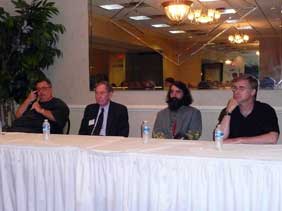 |
The infamous panel discussion (Ted, Bevin, Pat, Peter) |
By 9:30 PM, it was time for a panel discussion to wrap up the topic of Jackson's genius. It had Bevin Alexander, Peter Cozzens, and Pat Falci (the actor who has played A.P. Hill in the movies and who is, I am told, the president of the New York City Civil War Roundtable). The tension between Alexander and Cozzens was palpable and they made no attempt by the end to disguise their disdain for the other's arguments, which was rather exciting, but slightly appalling, given the normal propensity of these conferences to be very collegial. Both Pat and Peter emphasized how poorly Jackson did in treating his subordinates, not only court-martialing them at the drop of a hat, but keeping them in the dark as to the operational plans. Peter was obviously uncomfortable talking about speculative scenarios, but he stated that if Jackson had ever been given command of the army, he saw a number of parallels with the characteristics of Braxton Bragg. (He also asserted that Jackson never would have been given command anyway because he was not from the Southern aristocracy.) Bevin pushed back very hard on the secrecy aspect, stating that a good commander has to keep his plans secret and cited George S. Patton as an example of someone who used that technique. (My personal opinion is that from an operational standpoint, it is absolutely nuts to keep your second-in-command in the dark and I am quite certain Patton's staff knew his plans well enough.) The panel drew to a close and I hope they kissed and made up after I left.
Saturday
Today was our final day on the bus and it represented the most exhausting trip, probably racking up 250 miles. (About the one negative thing I could say about this conference is that the location in Maryland did not allow for any easy trips to the battlefields and time was frequently a factor. A hotel in Winchester would have been a lot more convenient.) We drove to Strasburg, where we got out of the bus for a rest stop and reviewed Jackson's movements from Harpers Ferry and Charles Town after Frémont's retreat from Winchester. Then it was a brief hop over to Lebanon Church, where there was an artillery duel between Frémont and Ewell. Jackson's army had to stay in position while it waited until the Stonewall Brigade returned from Harpers Ferry, hoping that the two Union armies bearing down on them would not close their pincer before he could escape. At Mount Jackson, we heard a description of Jackson's decisions on June 5-6 regarding the North River bridge at Port Republic and how he hoped to keep the two Union armies chasing him divided so he could defeat them in detail. As we crossed over the North Fork of the Shenandoah River, we were amused to see below the bridge an ATV sitting in the middle of the river, probably in 3 inches of water.
Our first battle-related stop was on Chestnut Ridge, a mile from Harrisonburg. Here, on June 6, there was one of many cavalry clashes and Turner Ashby (promoted to brigadier general just three days earlier) was killed. The United Daughters of the Confederacy has erected a monument near the spot where he fell. The ridge is being subjected to encroaching development, but the area that has been preserved is a nice, woodsy lot, a cool place on a hot day. Jonathan talked about the impact of Ashby's death. His aggressive bravery stirred admiration on both sides and some of Frémont's men were seen in tears when they heard the news. Many Valley communities still choose to celebrate Confederate Memorial Day on June 6 in his memory. The next battle stop was the Battle of the Waistline as we visited another Golden Corral for lunch.
Turner Ashby death marker |
Signal Point, Massanutten Mountain |
The hill at Cross Keys where the 8th NY fell |
We drove to Cross Keys to examine the fighting there on June 8, which did not really amount to much because Frémont never engaged a significant percentage of his force against Ewell. We stopped at the location of the Union Church, which was on the right flank of the Union line, and also the initial position of the famous 15th Alabama, some of whose men hid in the cemetery next door. Ed referred to "Fighting Bob Schenck," but explained that the nickname came from his political experience, not the war. (I can imagine a politician such as Sen. Harry Reid in a similar situation.) From the church we had a great view of Signal Point, the highest elevation at the southern end of Massanutten Mountain; the highest elevation on the northern end is called Signal Knob. Hurray for the Signal Corps! One of the really nice things about today was being in the Upper Valley, which is much more picturesque than the Lower. The weather was beautiful and the views of Massanutten, the rolling hills, and the Blue Ridge were spectacular.
We drove over to the farm next to the Widow Pence house and watched as Peter was able to pick the padlock on the gate keeping us out of the open field. (Presumably we had permission to be there, but no key.) We sit on the field where the 8th New York was slaughtered by volleys from Trimble's brigade as they came up over a slightly rounded hilltop. Ed made a big deal of singling me out and indicating that if I had been one of those New Yorkers, my head would have been exposed before anyone else's. The regiment suffered over 50% casualties. Trimble had a pretty good day at the battle, taking aggressive action without asking permission and tying up Frémont's attention until he finally gave up. I mentioned to Jonathan that my previous visit to this ground was with the late John Heatwole (with the CWPT Color Bearers in 2005) and he told me that just before John died, he gave Jonathan all of his files about the Shenandoah Valley. No wonder this young guy knows so much. :-) A final stop at Cross Keys was a curious small plot of land called the "Carrington Williams Interpretive Site," for which the CWPT has obtained some sort of an easement. It is right in the yard of a private house and it has all sorts of signs about not being allowed to take photographs (of the house, presumably, and of the family's plethora of political signs) and the place being off limits after 5 PM. For all of that trouble, there is not a lot to see from there anyway.
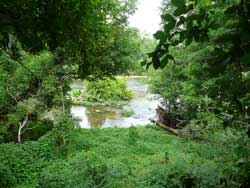 |
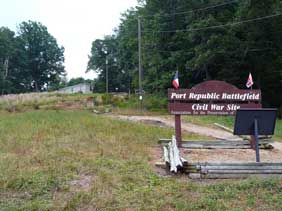 |
Abutment of North River bridge, Port Republic |
Looking up at the Coaling |
The final battle in the campaign was Port Republic. We started in the tiny downtown and saw an abutment of the original bridge over the North River, where on June 8 Stonewall Jackson had to direct artillery against a Union cavalry raid, a raid that forced him to gallop through the streets to avoid being captured. A block away was the Frank Kemper house, which is now the local museum. After Turner Ashby was killed, his body was brought to this house for display before he was buried and they have a little exhibit with a life-size death photograph on a plain coffin. There are also exhibits about the rivers and industry of the small town, as well as information about the Civil War battle. I was surprised to see my friend Nancy Hess briefly at the museum, but she slipped away without noticing me (I presume), so I was disappointed that I did not get to speak with her. Nancy and her husband Irvin are prominent in the preservation community and I have met them a few times at CWPT meetings. They are also the owners of the Widow Pence house, which I visited in 2005. From downtown we went to the "Coaling," which is a prominent hill on the battlefield (so named because they harvested trees on the hill to make charcoal for a blacksmith shop). We climbed up to the top—now reforested—and heard explanations of all of the Confederate assaults necessary to finally silence the Union guns on the hill. I am sorry to say that the time available to visit Cross Keys and Port Republic were really pretty inadequate in comparison to my previous visit, but it is always a good feeling to return to these hallowed grounds.
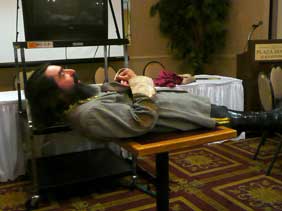 |
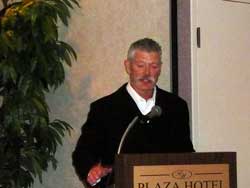 |
Pat Falci re-enacting his big coffin scene from Gods and Generals |
Stephen Lang |
During the 120-mile return drive, they decided to play a DVD on the bus's television system. It was The Wild Bunch, a rather violent Western that I cannot say I enjoyed very much. Upon our return, we had dinner on our own and then an evening about movies. Pat Falci told some funny stories about the making of Gods and Generals, for which he served as a researcher and technical advisor. A good deal of the production was filmed in Washington County, Maryland, the home county of Hagerstown. He told us that they filmed battle scenes for Antietam, but those were all left on the cutting room floor. The original plan was to film two movies at the same time, including Last Full Measure, the third volume in the Shaara Civil War trilogy, but they ran out of money. Ted Turner has discontinued his option on the book, so it seems really doubtful it will ever be filmed. (Stephen Lang said during his presentation that he would like to play Robert E. Lee if that film is ever produced.)
Stephen Lang—who played George Pickett in Gettysburg and Stonewall Jackson in Gods and Generals—rounded out the program and he did a really outstanding job getting us into the head of an actor attempting to portray a historical figure. I wasn't watching my watch, but he must have talked for at least an hour and the time just flew by as he described a number of the roles he has played in his career, as well as some famous performances by multiple actors portraying the same character in different ways. His primary example was Doc Holliday played by Val Kilmer and Dennis Quaid, which was a little over my head because I have seen neither movie. In his career, his most challenging and favorite role was Babe Ruth, much to my surprise, because I am used to the beefier actors. I asked him a question about how he developed the voice for Jackson (which to my untrained ear didn't sound all that different from his regular speaking voice) and he talked about all of the research he performed and how much time he spent with voice coaches to develop the West Virginia style accent. He said that you have to be a two-handed actor to play Stonewall Jackson, because you need one hand to hold Bud Robertson's biography and the other hand to hold the Bible. This was a delightful evening with an outstanding speech by a talented, humorous, thoughtful, decent man.
Sunday
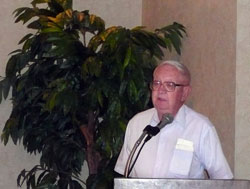 |
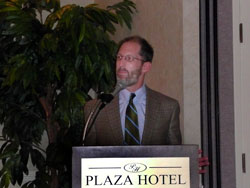 |
John Schildt |
Paul Anderson |
There were three sessions scheduled for Sunday morning, but I had a flight to catch at Dulles, so missed the last, yet another Q&A with the historians (as well as about the fifth raffle of the week!). The first session was John Schildt, who spoke about the spiritual life of Jackson. I did not get a lot of insights from this one, although he delivered his material well. I was taken with his remarks that Jackson's faith and life were oriented toward the teaching of the New Testament, but he fought with the ferocity of an Old Testament general.
Paul C. Anderson gave a talk about the Life and Death of Turner Ashby, but it turned out to be a pretty disappointing academic treatise about Ashby's "aura" and the truth versus the accuracy of lies told about him in the context of brutal border warfare. The interesting aspect was that this guy has the famous Ashby death photo displayed in his living room. His wife apparently has a different attitude about such things than mine does. :-)
All in all it was a generally interesting conference, not up to the standards of Antietam a couple of years ago, but worthwhile. The biggest drawback was the excessive travel time required, which was tiring, but more importantly it also squeezed out some content and made the bus tours too rushed. Next year's edition was announced as "Cedar Mountain to Antietam" and that sounds like a real travel slog, but I'll wait to see next year what the logistics will be.
Abraham Lincoln Bicentennial Exhibit, Sacramento
I drove up to Sacramento on August 15 to visit "With Malice Toward None: Abraham Lincoln Bicentennial Exhibit" at the California Museum, an exhibit that is traveling around the country from the Library of Congress. This will be a short review and they did not allow photographs. It was moderately interesting, although the experience was degraded by two factors: it was pretty crowded and the waits to see individual documents extended into the minutes each, and; to protect the historic handwritten documents, they had the lights very dim in the exhibit hall and it was really difficult to read them. (And they never mount these exhibits so that really tall people can see them without stooping over. Harrumph!)
I stood in line for quite a while at the early documents from Lincoln's life, but decided to move into the wartime portion, which was not as crowded, interestingly enough. I was pleased to note that there were no obvious errors or gross simplifications, which you often see in museum exhibit signage. Some of the documents that I thought were most interesting were:
-
The original draft of the Gettysburg Address,which had slightly different wording than the text we know from history. The sentence "It is altogether fitting and proper that we should do this" was written as "This we may, in all propriety do." The first page of the document was written on White House ("Executive Mansion, Washington") stationery, but the second is on plain paper, indicating that Lincoln was dissatisfied with one of the sentences near the end and he replaced it on the trip to Gettysburg.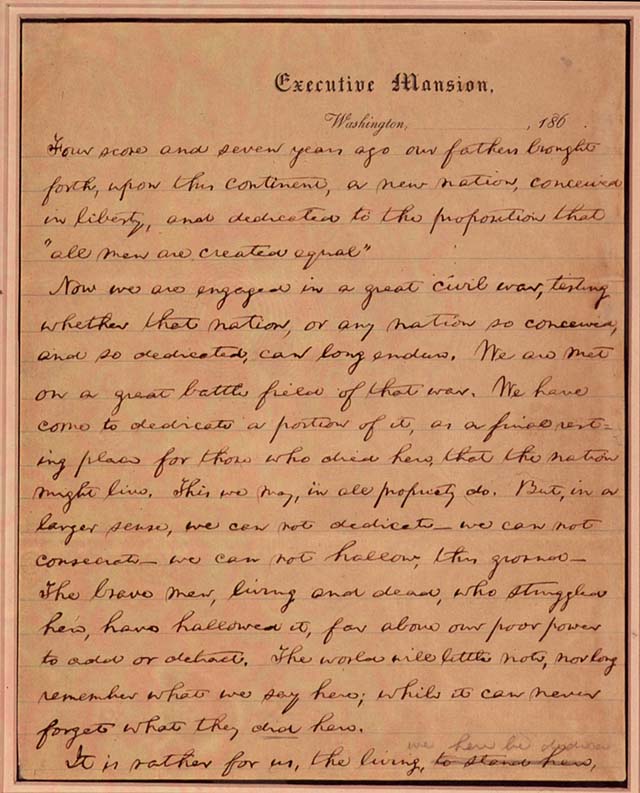
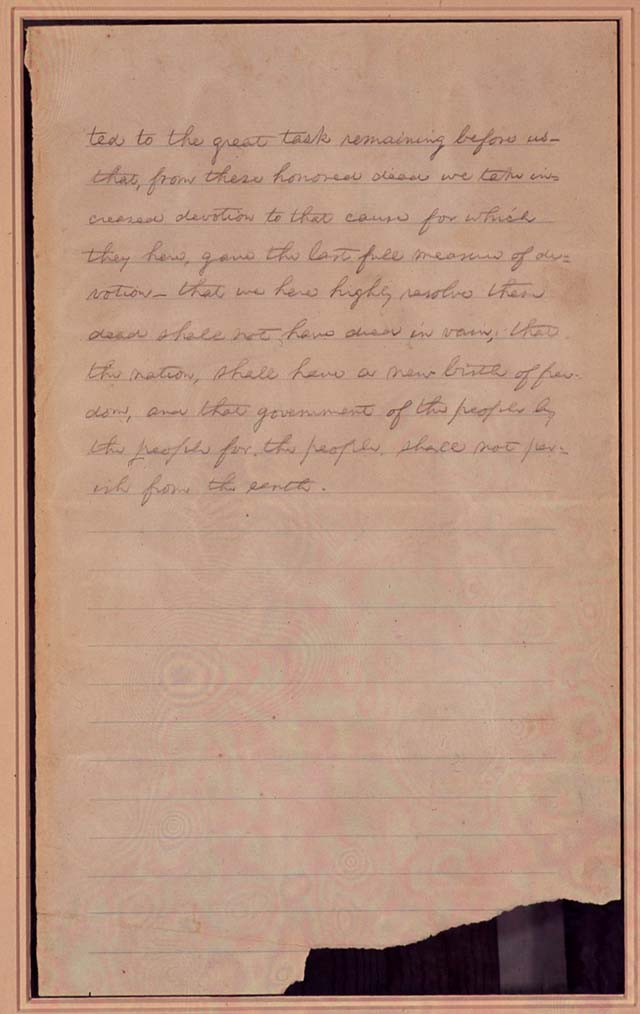
- Lincoln's letter to Joseph Hooker after he was given command of the Army of the Potomac, in which he somewhat humorously said that he would risk a dictatorship if Hooker brought him victory.
- Lincoln's letter to George Meade on July 14, 1863, criticizing his lack of pursuit of Lee after the Battle of Gettysburg—the letter that Lincoln kept in his desk drawer rather than sending.
- Lincoln's letter to Ulysses S. Grant, promoting him to Lieutenant General.
- A facsimile of the handwritten Special Order 191, which was lost by one of Robert E. Lee's men during the Maryland Campaign, falling into the hands of George B. McClellan. (I was obviously familiar with the text of this order, but I had never seen it handwritten.)
- A number of original battlefield sketches by Edwin Forbes and Alfred Waud.
Other than the logistical problems of the exhibit itself, it was really interesting to see all of this history, particularly those in Lincoln's own handwriting.
Continue to Part 4 of my 2009 travels.
